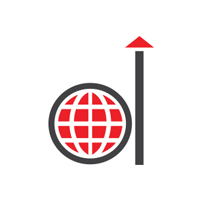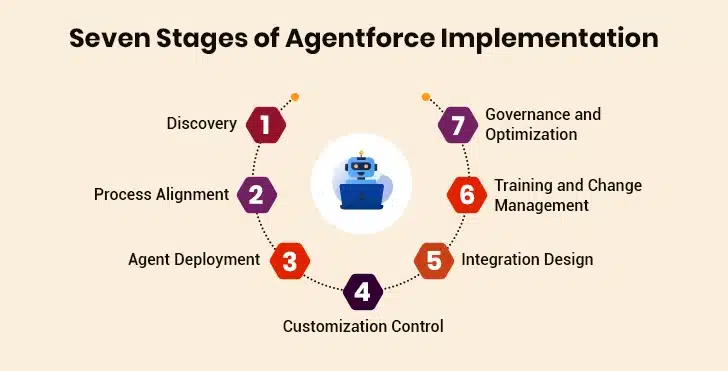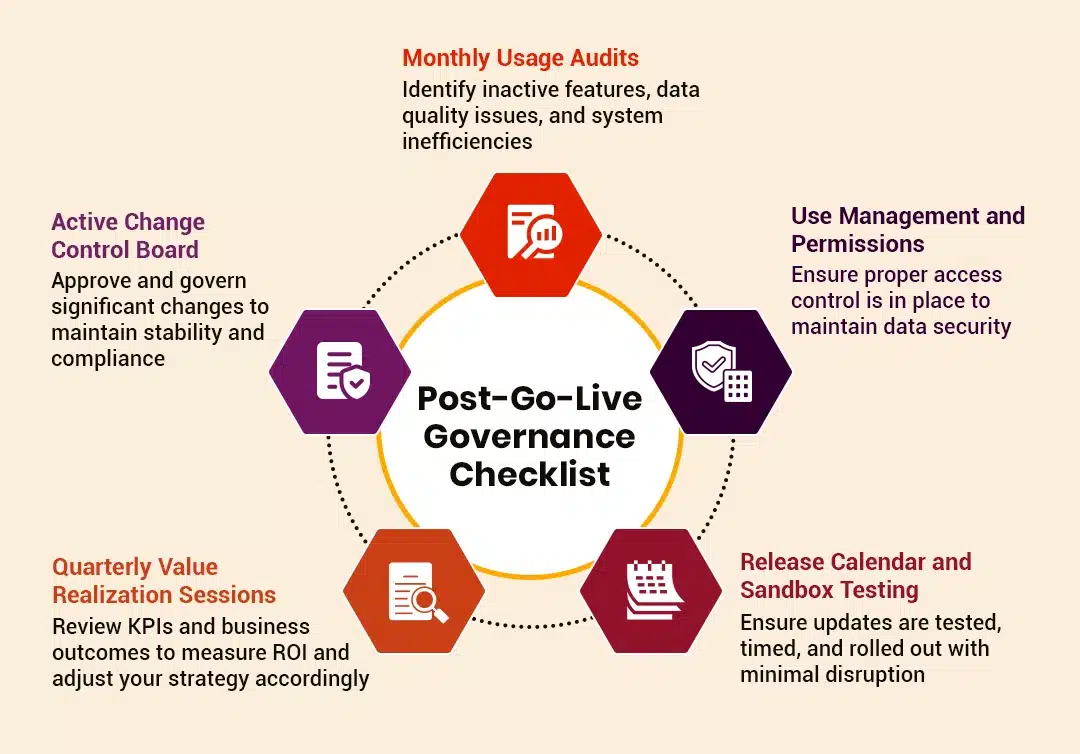“If you can describe (dream) it, Agentforce can do it” – Salesforce.
Disrupting business operations with its transformative capabilities, from intelligent automation and enhanced customer experiences to becoming the ever-present assistant of human teams, Salesforce Agentforce is far beyond an average AI tool. It was launched in September 2024, during Dreamforce, and has since become an ally for businesses seeking to develop, customize, and deploy their own autonomous AI agents.
Although Agentforce enjoys a higher success rate as compared to other similar platforms, the implementation process is often riddled with various challenges, such as delayed projects, unnecessary customizations, and user resistance. When first-call resolution and speed-to-service make or break the deal, such challenges and failed implementations come bearing repercussions that are not just limited to brand damage and overheads.
This guide identifies the top ten Agentforce implementation pitfalls and offers actionable strategies to help businesses avoid them.
Table of Contents
What is Agentforce?
“Agentforce represents the Third Wave of AI—advancing beyond copilots to a new era of highly accurate, low-hallucination intelligent agents that actively drive customer success.”– Marc Benioff, Chair and CEO, Salesforce.
Salesforce Agentforce is an agentic AI platform built directly on Salesforce. It enables users to create intelligent, proactive agents that can act, rather than just provide suggestions.
These agents can answer questions, trigger workflows, update records, or even complete entire business processes across customer service, sales, marketing, operations, and more.
Key features include:
- Lead routing and scoring
- Real-time data adaptation
- Pre-built skills library
- Seamless Salesforce integration
- Testing center
Still, its flexibility is a double-edged sword; when poorly configured, it becomes clunky, underused, and costly.
Why Implement Agentforce?
Salesforce Agentforce isn’t just another CRM add-on. It’s a full-stack AI engine that has already proven its worth at the enterprise scale.
The numbers, as per Salesforce’s Q1 2026 revenue reports, speak loudly:
- Agentforce has generated over 8,000 deals, demonstrating its commercial prowess in real-world deployments.
- Agentforce combines data analytics and AI to pave the way for proactive case management. It has processed more than 750,000 support requests via help.salesforce.com, resulting in a 7% year-over-year decrease in case volume.
- By automating service workflows, Salesforce rebalanced 500 support staff into high-impact AI roles, unlocking $50 million in operational savings.
All in all, Agentforce helps teams close more deals, handle support better, and work smarter. Businesses save time and money, but more importantly, they free up their people to focus on what really matters. As customer expectations grow, Agentforce gives teams the tools to stay ahead and deliver better outcomes, every step of the way.
What are the Common Salesforce Agentforce Implementation Mistakes and Ways to Avoid Them?
Several organizations that were enthusiastic about Salesforce Agentforce earlier complained of implementation challenges during the process. It is important to understand that these challenges hardly stem from the platform’s technical flaws; the lack of a well-thought-out roadmap and strategic foundation is the primary reason. Teams over-automate processes without aligning them with business goals and migrate data from legacy systems without proper data cleaning. The cumulative impact of these missteps turns a highly autonomous platform into a technical debt. Let’s explore these pitfalls in detail:
1. Lack of Strategic Alignment
The Problem
Many organizations begin implementation with a technology-first mindset instead of a strategy-first approach. They treat Agentforce like a plug-and-play tool. They assume Agentforce will “fix” broken processes without first identifying which business goals it’s supposed to support.
Without this alignment, businesses:
- Waste time configuring low-impact features
- Build agents that solve the wrong problems
- Fail to rally stakeholders behind a unified vision
How to Avoid It?
- Define what success looks like in terms of retention rates, operational costs, and agent performance, not just system uptime.
- Align the Agentforce roadmap with strategic initiatives and prioritize use cases.
- Include line-of-business leaders across customer service, sales, and marketing, not just IT and Salesforce admins, in discovery sessions.
How Salesforce Experts Help?
Salesforce consultants lead with a strategy-first approach, ensuring that every feature in Salesforce Agentforce supports key business objectives. They conduct discovery sessions across departments and align Salesforce Agentforce implementation with market expansion, customer engagement, and long-term growth metrics. To avoid early missteps, consultants follow a clear implementation strategy.
2. No Defined Success Metrics
The Problem
Businesses can’t optimize what they don’t measure. Yet most teams measure implementation by technical completion (go-live) rather than business impact. The system may be alive, but is it delivering value?
Without metrics, businesses risk:
- Misjudging adoption success
- Missing early signs of inefficiencies
- Inability to prove ROI to stakeholders
How to Avoid It
- Define pre- and post-launch KPIs, such as sales conversion rates, customer lifetime value, agent onboarding time, and call drop-off rates.
- Map existing workflows, pain points, and bottlenecks to create a better vision for Agentforce.
- Schedule Value Realization Reviews quarterly to assess where AI agents are helping or hindering progress.
Once Agentforce goes live, it becomes imperative to track success against business objectives. These KPIs help track real business outcomes:
How Salesforce Experts Help?
Implementation partners help define KPIs that are directly tied to the business value. They configure dashboards to track these metrics, ensuring that businesses continue to achieve the desired outcomes. This forms the cornerstone of accountable Salesforce Agentforce development.
Handy Tip: Link employee incentives to key performance metrics, such as resolution speed and conversion rates.
3. Over-Engineering Solutions Without a Clear Scope
The Problem
The Salesforce Agentforce is flexible, but that doesn’t mean businesses should customize everything to the point of overkill. With over 1,000 pre-defined actions available, businesses often end up over-customizing the AI agents. Over-engineering leads to:
Without this alignment, businesses:
- Long dev cycles
- Higher development and maintenance costs
- Limited agent accuracy
How to Avoid It?
- Add functionalities incrementally without disrupting existing processes.
- Meticulously design agent topics and actions for LLM-driven responses.
- Maintain a customization governance board that reviews every significant code addition for business value.
How Salesforce Experts Help?
Skilled consultants prioritize scalability over complexity. They steer teams toward native Agentforce capabilities and limit unnecessary customization. They are also future proof the system by reducing tech debt and ensuring smooth upgrades.
Get Expert Agentforce Implementation Guidance
4. Poor Data Quality and Governance
The Problem
If data is inconsistent, incomplete, or duplicated, Agentforce becomes a liability rather than an asset. Still, many teams underestimate the role of clean data in Salesforce Agentforce. Even minor mismatches in fields or formats can snowball into system-wide disruptions. Common pitfalls include:
- Not prioritizing metadata documentation
- Bringing over incomplete or inaccurate data
- Not establishing clear rules for data governance
How to Avoid It?
- Start with a data quality audit. Cleanse, enrich, and de-duplicate data before the first import.
- Use the Data Cloud vector database and Prompt templates to query unstructured data.
- Document a data dictionary that outlines how every field in Agentforce maps to business intent.
How Salesforce Experts Help?
Salesforce partners are crucial in navigating the complexity of the Data Cloud for Agentforce. They help by strategically assessing if full Data Cloud implementation is genuinely needed, beyond just Agentforce’s tracking data requirements. This creates a clean launchpad for dependable Salesforce Agentforce development.
Tip: Create dashboards post-launch to track data hygiene issues, such as incomplete records, duplicate contacts, or orphaned opportunities.
5. Ignoring User Roles and Profiles
The Problem
Agentforce is a shared workspace for agents, CSRs, and sales managers. However, giving everyone access to everything can overwhelm users and expose the data to risks. Hence, managing access in a multi-user system like Agentforce requires careful planning and consideration.
Without persona-specific views, users struggle with:
- Navigation confusion
- Unnecessary fields and buttons
- Delayed productivity
How to Avoid It?
- Clearly define the role and purpose of each agent.
- Use granular access control to create different roles and set permissions.
- Create dedicated Salesforce integration for users and profiles for Agentforce.
How Salesforce Experts Help?
Consultants play a critical role by conducting detailed security assessments. They design clean, role-based views and apply precise access controls. This helps teams enjoy greater clarity and compliance.
Tip: Restrict access to sensitive data using Field-Level Security and Permission Sets.
6. Not Integrating with Core Business Systems
The Problem
Agentforce alone can’t do everything. If it doesn’t integrate with ERP and other third-party solutions, users are forced to toggle between apps, which kills productivity. Thus, businesses miss out on:
- Real-time business insights
- Cross-system workflows
- Consistent customer experiences
How to Avoid It?
- Define the integration architecture early in the project.
- Develop prebuilt connectors for enterprise platforms.
- Build bidirectional data syncs to keep Agentforce as the source of action and insight.
How Salesforce Experts Help?
SWhile Agentforce is natively integrated within Salesforce, consultants ensure that Agentforce connects seamlessly with non-Salesforce business systems. They develop custom APIs and ensure secure integration. The result is a unified ecosystem where Salesforce Agentforce for customer services acts as the nucleus.
7. Skipping Change Management
The Problem
The Salesforce Agentforce is flexible, but that doesn’t mean businesses should customize everything to the point of overkill. With over 1,000 pre-defined actions available, businesses often end up over-customizing the AI agents. Over-engineering leads to: Change is hard. If people don’t understand the “why” behind Agentforce implementation or feel it makes their job harder, they’ll resist, delay, or reject it outright. Without buy-in, even the most well-built system falls flat. Misalignment between vision and daily workflows creates friction, resulting in:
- Low adoption rates
- Shadow IT workarounds
- Frustrated employees and managers
How to Avoid It?
- Start with a change readiness assessment.
- Build a training plan by persona while focusing on practical application.
- Use Salesforce In-App Guidance for just-in-time learning.
How Salesforce Experts Help?
Consultants lead organizational change with finesse. They run readiness assessments, build role-specific training plans, and deploy just-in-time learning tools. They also identify power users across departments who act as early champions, accelerating Salesforce Agentforce adoption from the inside out.
Tip: Identify and empower “super users” in each region to champion the system and offer peer support.
8. No Post-Go-Live Governance
The Problem
Without governance, systems drift from their original purpose. Feature bloat, messy data, and rogue customizations creep in. Moreover, teams often lose clarity on how the system works. Over time, businesses witness:
- Feature sprawl
- Security and compliance lapses
- Non-compliant data practices
How to Avoid It?
- Establish a dedicated governance committee for Agentforce.
- Utilize release management best practices, including sandbox testing and version control.
- Audit the performance of agents using Agentforce Analytics and Data Cloud reports.
Going live is not the end of the journey. Sustained performance requires strong governance practices like these:
How Salesforce Experts Help?
Salesforce experts help set up governance models. They implement structured release cycles, enforce change control, and monitor performance. This ensures the Salesforce Agentforce implementation stays value-driven and future-proof.
9. Underutilizing Agentforce Features
“Embracing an AI-first world means reimagining an enterprise where humans and intelligent agents don’t just coexist, they collaborate,” – Athina Kanioura, Chief Strategy and Transformation Officer at PepsiCo.
The Problem
According to Salesforce, 84% of CIOs believe AI will be as transformative as the internet itself, yet many struggle with its real-world implementation. Agentforce is already pointing the way forward with proactive AI features and predictive automation. Ignoring these capabilities means:
- Higher manual handoffs and errors
- Increased technical debt
- Suboptimal AI agent performance
How to Avoid It?
- Integrate advanced capabilities, such as Retrieval Augmented Generation (RAG), to enhance AI responses.
- Set up complex Flow-based actions and custom Apex invocable methods to automate complex processes.
- Use AI observability tools and custom performance dashboards to track feature utilization.
How Salesforce Experts Help?
Salesforce experts identify automation gaps and implement intelligent workflows to reduce manual effort. They orchestrate robust data integration for RAG and develop sophisticated prompt templates and custom actions. Experts also implement AI observability and fine-tune processes to ensure continuous, high-value technical optimization. All in all, they transform Salesforce Agentforce development into a proactive engine for growth.
10. Not Outsourcing Implementation
The Problem
Many firms opt for Salesforce Agentforce implementation by in-house teams that lack the necessary skills, tools, and knowledge. The result? Inaccurate data models missed compliance needs, and poorly designed AI agents. This misalignment can lead to costly rework and delayed go-lives.
How to Avoid It?
- Assess the Salesforce expertise of in-house IT teams carefully and thoroughly to identify key gaps in the required skillset.
- Request a team of certified Salesforce consultants who have prior experience working in your industry.
- Before signing off for the team, ask for a trial session or technical discovery session.
How the Right Expert Can Help?
A specialized consultant brings domain expertise that aligns Agentforce with industry workflows and compliance standards. They anticipate regulatory nuances and configure the system accordingly. Their experience reduces rework, accelerates the go-live process, and lays the groundwork for long-term scalability and success.
Red Flag: If a partner can’t provide a phased rollout plan, they may not be the right fit.
Final Thoughts
Salesforce Agentforce can revolutionize any business, but only if implemented with foresight, discipline, and agility. Avoiding these ten pitfalls will help companies achieve successful adoption.
After all, the cost of failed implementation isn’t just budget; it’s lost trust, reduced productivity, and customer churn. Hence, invest in planning, prioritize training, embrace automation, and govern ruthlessly.
FAQs
Q. What industries is Agentforce best suited for?
A. Agentforce is well-suited for a range of industries. These include healthcare, manufacturing, automotive, media, and retail, among others. It’s also used across various business functions, including customer service, sales, and marketing.
Q. What are the most common challenges in implementing Salesforce Agentforce?
A. The most frequent pitfalls include poor data planning, over-customization, unclear success metrics, and weak change management. Without a strategy-first approach and post-launch governance, even powerful tools like Agentforce can underperform.
Q. Why do some Agentforce implementations stall or fail?
A. Many Agentforce rollouts fail due to strategic misfires and easily avoidable blunders. Without business alignment and user readiness, even robust platforms can become digital deadweight. Projects falter due to common missteps, such as:
- Skipping change management or not preparing users for the transition
- Over-customizing instead of using built-in features
- Replicating outdated legacy workflows without a strategic rethink
- Failing to define clear KPIs and business alignment from the start
- Choosing the wrong implementation partner








